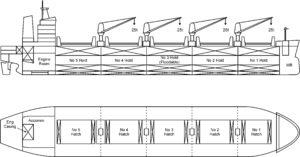Bulk carrier

The Sabrina I is a modern Handymax bulk carrier.
|
|
| Class overview | |
|---|---|
| Subclasses: | Handymax, Handysize, Panamax, Capesize |
| Built: | c. 1850–present |
| Active: | 9,570 vessels over 500 GT (2012) |
| General characteristics (typical) | |
| Type: | Bulk carrier |
| Tonnage: | up to 400,000 DWT |
| Propulsion: | 2-stroke diesel engine and 1 propeller |
| Notes: | Rear house, full hull, series of large hatches |

Plans of a geared Handymax bulker
|
|
A bulk carrier, bulk freighter, or bulker is a merchant ship specially designed to transport unpackaged bulk cargo, such as grains, coal, ore, and cement in its cargo holds. Since the first specialized bulk carrier was built in 1852, economic forces have fuelled the development of these ships, causing them to grow in size and sophistication. Today's bulkers are specially designed to maximize capacity, safety, efficiency, and durability.
Today, bulkers make up 15% - 17% of the world's merchant fleets and range in size from single-hold mini-bulkers to mammoth ore ships able to carry 400,000 metric tons of deadweight (DWT). A number of specialized designs exist: some can unload their own cargo, some depend on port facilities for unloading, and some even package the cargo as it is loaded. Over half of all bulkers have Greek, Japanese, or Chinese owners and more than a quarter are registered in Panama. South Korea is the largest single builder of bulkers, and 82% of these ships were built in Asia.
A bulk carrier's crew participates in the loading and unloading of cargo, navigating the ship, and keeping its machinery and equipment properly maintained. Loading and unloading the cargo is difficult, dangerous, and can take up to 120 hours on larger ships. Crews can range in size from three people on the smallest ships to over 30 on the largest.
Bulk cargo can be very dense, corrosive, or abrasive. This can present safety problems: cargo shifting, spontaneous combustion, and cargo saturation can threaten a ship. The use of ships that are old and have corrosion problems has been linked to a spate of bulker sinkings in the 1990s, as have the bulker's large hatchways, important for efficient cargo handling. New international regulations have since been introduced to improve ship design and inspection, and to streamline the process of abandoning ship.
There are various ways to define the term bulk carrier. As of 1999, the International Convention for the Safety of Life at Sea defines a bulk carrier as "a ship constructed with a single deck, top side tanks and hopper side tanks in cargo spaces and intended to primarily carry dry cargo in bulk; an ore carrier; or a combination carrier." However, most classification societies use a broader definition where a bulker is any ship that carries dry unpackaged goods.Multipurpose cargo ships can carry bulk cargo, but can also carry other cargoes and are not specifically designed for bulk carriage. The term "dry bulk carrier" is used to distinguish bulkers from bulk liquid carriers such as oil, chemical, or liquefied petroleum gas carriers. Very small bulkers are almost indistinguishable from general cargo ships, and they are often classified based more on the ship's use than its design.
...
Wikipedia
